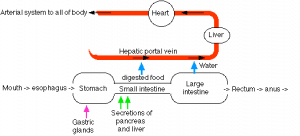14 Energy and growth

Requirements for growth
Many things have to happen for the nutrients we eat to actually turn into energy and components that we can use for growth.
We have to eat the right things and in the right proportions
- Veterinary diets are formulated to solve this problem. The name brand foods (with a nutritionist involved) include essential vitamins and minerals as well as the right balance of proteins, carbohydrates and fats. If pets or livestock eat diets developed by nutritionists, they are usually eating the right things in the right proportions. When we change that diet, we can have issues.
- Diet fads can impact animals. Raw diets are not healthier than dog chow. Cat are obligate meat eaters; dogs are not. Dogs do not need to eat “low carb”. Cats cannot survive as vegetarians.
Try this
Food labels are less restrictive for animal foods vs human foods. Check out the labels of different animal foods at the grocery store. What details are missing? How do the ingredient lists differ?
We have to eat enough food to meet metabolic demands
- We need to be ingesting enough calories to meet the body’s demand or we have a “negative” energy balance. A negative energy balance means we are using more calories than we are taking in. Higher energy needs are required for growth, lactation, extra work, illness, neoplasia and the last trimester of pregnancy.
- Nutrients may be lost with various disorders. In particular, proteins can be lost through the skin (burn wounds), the GI tract, and the kidneys. If proteins are being lost, more are required in the diet to meet the body’s requirements.
Try this
While you are looking at those food labels, look for the area that says how much to feed. Does it give information about feeding animals that are underweight, overweight or have increased metabolic demands? Or does the company make different foods for pregnant animals and overweight animals? If so, how do those products differ?
The things we eat have to be turned into digestible particles
- Chewing helps break food material into smaller pieces with more surface area; this allows it to be digested more effectively. Older animals may not be able to chew as well. Certain dietary components are also harder to chew or to break down (straw, later cuttings of hay, corn, soybean hulls)
- We have to swallow what we eat. If the animal cannot swallow, is regurgitating or vomiting, that food is lost and cannot be used by the body.
The material has to move through the GI tract
- Most digestion typically occurs in the small intestine. Digestion can’t happen if food isn’t eaten, is regurgitated or vomited, or if it gets stuck proximal to the small intestine
- When motility is sped up, digestion and absorption may not have time to occur
Food must be broken into absorbable compounds
- We don’t have transport mechanisms to move larger proteins, fats or sugars from the intestinal lumen into the cell. We can absorb disaccharides, monosaccharides, monoglycerides, fatty acids, amino acids and some peptides. We use pancreatic enzymes to break larger food molecules into smaller absorbable molecules.
- Many of these enzymes are stored in an inactive form in the pancreas to prevent pancreatic self-digestion; these must be activated to work. Bile from the liver is also required for fat digestion. Multistep processes mean more things can go wrong.
- Intestinal segmentation (mixing) activity also helps mix the enzymes with the food. If the intestine isn’t contracting properly, digestion as well as absorption can be impaired.
- Different species have different enzymes and hence different dietary requirements. For instance, most adult cats have lost the enzyme lactase and cannot digest milk.
- Gut microflora (the microbiome) also play in role in digestion, particularly in herbivores. In ruminants, almost all of the nutrition comes from microbial products. Hence, cow diets are designed to primarily feed the microflora. The microflora feed the cow.
- If the microflora are killed off or are abnormal, digestion of hays and grasses will be impaired. In addition, microflora produce certain nutrients that are not otherwise available in diets.
Try this
Many adult humans have also lost the ability to digest milk. Ask your family members if they can still eat ice cream and drink milk. If they have lost lactase, how do these foods impact them? What do they do to help minimize side effects?
Nutrients must be absorbed
- Absorption of nutrients mostly occurs in the villi of the small intestine
- The villi are designed so that the digestion products can easily reach the vessels and lymphatics by passive diffusion
- If the villi are too thick, damaged or otherwise dysfunctional, absorption may not occur even with proper digestion.
Nutrients must be distributed to other parts of the body
- Most nutrients pass out of the GI tract and go into the portal vein system and to the liver before being disseminated through the body. The liver filters out toxins and may further metabolize dietary components. If the portal system or liver function is abnormal, the nutrients may not make it to the rest of the body. Fats must also be disseminated by the lacteals.
Causes of weight loss- Malone lecture
Pick one to think through or research:
- When do we(or other animals) gain weight vs lose weight?
- What are the current recommendations for endurance diets (dogs, horses, humans)?
- What vitamins and minerals are required(any species)? What happens with deficiencies?
folds of tissue that increase surface area, particularly in the small intestine

